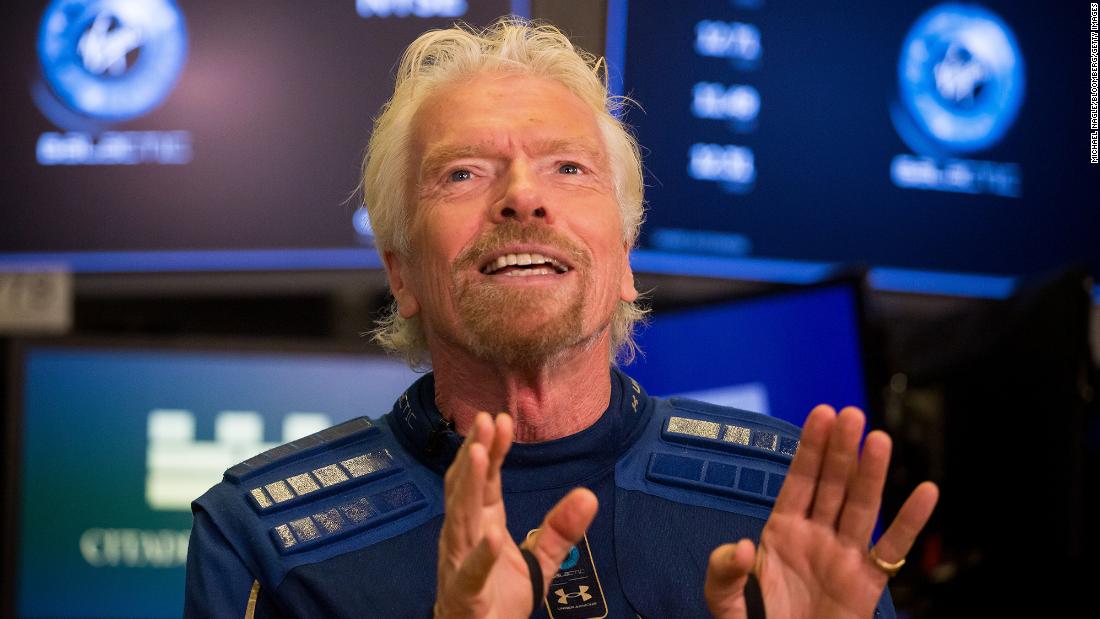Virgin Galactic’s Richard Branson wants to be the first ‘space billionaire’ to actually travel to space

Branson is the only one among the group of the so-called space barons, the group of space-loving billionaires that includes Elon Musk and Jeff Bezos, who has publicly pledged to take a ride in the near future aboard a spacecraft he has bankrolled. Bezos’ company, Blue Origin, is working on a competing suborbital space tourism rocket. Musk’s SpaceX, however, is focused on transporting astronauts and perhaps one day tourists on days-long missions to Earth’s orbit.Branson made dozens of media appearances over the past decade touting various deadlines for his extraterrestrial journey that didn’t hold true, in part because building a spacecraft almost always takes longer than expected and because SpaceShipTwo development was hampered by two tragic accidents and — more recently — a pandemic. Virtually every year since 2004 the company has claimed it would be flying customers in a year or so. On Thursday, however, Virgin Galactic set yet another deadline for Branson’s flight: Sometime between January and March of 2021. Notably, that declaration didn’t come from Branson. This time it came from Michael Colglazier, the recently installed CEO of Virgin Galactic whose goal is to guide the company as it grows from an engineering project in the California desert into a multibillion-dollar space tourism business. Colglazier was speaking not to reporters, but to Virgin Galactic investors who bought into Branson’s vision after the company made its stock market debut in late 2019. (The company’s valuation has grown to $4.5 billion, though it’s still burning through more than $20 million per month as it trudges through the final stages of SpaceShipTwo’s testing and certification process.) Branson has less of a financial stake in Virgin Galactic’s success than he did 16 years ago, as well. He sold off about a quarter of his shares amid controversy and Covid-19-related financial issues at his airline, Virgin Atlantic.But Colglazier’s message on Thursday made clear that Branson, who turned 70 this year, is still planning to be the poster child for Virgin Galactic’s assertion that almost anyone can safely make the trek. Is it dangerous? Proponents of commercialized human spaceflight have long argued that danger — and even tragedy — should not quell humanity’s appetite to travel into space. Virgin Galactic experienced its first tragedy in 2007 when three people were killed and several others severely injured during a rocket engine test conducted by employees of Scaled Composites, Virgin Galactic’s engineering and manufacturing partner. It sparked steep criticism from aerospace safety experts and led to an investigation from federal authorities, but the company pressed forward. “Sadly, I think because the space program was run by governments, there was never any real interest in enabling members of the public to go to space” after NASA’s Space Shuttle Challenger disaster in 1986, Branson told the Wall Street Journal in 2013. “I would say 90% of people my age thought they would go to space because they saw the moon landing.” One year later, tragedy struck Virgin Galactic again. The company’s prototype space plane broke apart during a test flight over the California desert, killing 39-year-old co-pilot Michael Alsbury. Brason faced allegations that Virgin Galactic had ignored safety warnings, which he denied. “If any of our rocket engineers warned something wasn’t safe to go we wouldn’t go,” Branson told the BBC at the time. “We take safety very, very carefully. Nobody said anything to worry any of the team about going.” Ultimately, it was determined that pilot error caused that crash. Virgin Galactic parted ways with Scaled Composites, reorganized its manufacturing business and — within two years — had a new, fully assembled SpaceShipTwo with added safety features. That vehicle, named VSS Unity, went on to perform flawlessly in a 2018 test mission. Branson watched from the ground as the spacecraft screamed to more than 50 miles above Earth’s surface at three times the speed of sound before landing safely back at Virgin Galactic’s testing facilities in rural California a short time later. Another successful test flight in 2019 carried its first passenger, and it wasn’t Branson. It was Virgin Galactic’s safety and training chief, Beth Moses, who tested comfort of the ride from the spacecraft’s cabin. She described the experience as “intense” but not “overly dramatic.” At least eight more Virgin Galactic employees will fly on SpaceShipTwo before Branson’s flight. The company said it plans to fly another test with only two pilots this fall, and another trip with two pilots and four test passengers will take off in early 2021. All that will aim to get a seal of approval from the Federal Aviation Administration, certifying SpaceShipTwo for commercial operation. Branson will be on the next flight after that. It remains unclear if Virgin Galactic’s business model — or any space tourism business — can be made into a successful and sustainable money-making enterprise. But Virgin Galactic executives have acknowledged for years that its success or failure will hinge on whether or not the company convinces the general public that the trip can be not just safe, but worth the hefty per-seat price tag.



